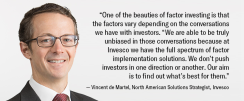Editor’s note: This is the second of two stories on achieving truer diversification by using analytical diagnostics and factors, and implementing the resultant strategies. To read the first part, go here.
Factor diagnostics can be transformative for even the savviest investors, as factors can reveal quantitative evidence that helps assess and shape allocation strategy, and they lay transparent the key characteristics of a portfolio for all to see. Even the best strategies, however, have to be effectively and efficiently implemented to ultimately achieve success1.
From the viewpoint of Vincent de Martel, North American Solutions Strategist at Invesco, implementing factor strategies that could potentially reap benefits for investors should consider three things:
- Practitioner evidence,
- Academic evidence, and
- A solid grasp of the rationale behind the positive risk premium.

Finding the evidence
Factor investing is not about inventing new sources of alpha, according to de Martel. Rather it is looking carefully for persistent sources or market anomalies that can help justify excess return over time. Often, that means looking at what some asset managers have been doing for many years, i.e. practitioner evidence. “There are existing opportunities in the market that have been historically identified by alpha-driven managers that were doing stock selection in a very active style. The development of technology allows these stock-specific decisions to now be applied on a wide scale.”
On the academic front, university researchers often study factors as an evolution of their work on the capital asset pricing model. It has been proven by academia, for example, that in suitably diversified portfolios, factors drive risk and performance outcomes2 – and, of course, getting factor diversification right is at the heart of factor diagnostics and implementation.
Understanding why there should be an excess return, de Martel’s third key point for factor implementation, is equally important as the first two. “I don’t think a factor investor should invest just because they’ve seen a nice back test. Relying exclusively on past performance to determine if a factor strategy will outperform a market capitalization-weighted reference in the future is a dangerous path to follow.”
As an example, de Martel discusses a value factor. “If you screen a list of securities and you pick the ones with the lowest price based on comparison of price to earnings, or to book value, or to revenues in some cases, you’ll have a group we call unloved stocks. Over long periods, unloved stocks tend to have higher returns than more glamorous stocks. Why is that? From a behavioral perspective, investors are attracted to high-growth companies. It’s common to believe that based on past performance that growth will be maintained in the future, so investors tend to overpay for growth stocks. At some point, however, the market mentality changes and investors realize that they have probably been overestimating growth. As a result, they punish the price of the glamorous stocks and they up the prices of the unloved stocks, which at the end of the day tend to deliver more attractive risk return characteristics.”
Opportunity in premiums
When an investor selects securities based on certain factors they are, in short, looking for a premium. The premium comes from two sources: First, a portfolio made up of securities selected based on certain attributes is expected by investors to outperform the market3; and, second, the excess return from this portfolio does not move in lockstep with the market, thus increasing its diversification potential.
“If you don’t take advantage of those premiums, you might be leaving return on the table,” de Martel says. “You could argue that that if you’re not truly taking advantages of factors, you are uncompensated for the risk you’re taking.”
While true factor diversification can help minimize uncompensated risk, such as de Martel describes, construction of a factor portfolio highly depends on the outcomes investors seek. There is no one-size-fits-all construction, which can be a revelation to some investors who believe they simply can invest in a standard list of factors.
“One of the beauties of factor investing is that the factors vary depending on the conversations we have with investors,” says de Martel. “We are able to be truly unbiased in those conversations because at Invesco we have the full spectrum of factor implementation solutions. We don’t push investors in one direction or another. Our aim is to find out what’s best for them.”
As it turns out, Invesco has just released the third edition of its factor investing survey, including interviews with 300 global institutions that have adopted factor investing and that represent nearly $19 trillion in assets. Intriguingly, while survey results indicate that barriers to adopting factor strategies have fallen, the primary need investors want to fill remains their own education on factors.
“At Invesco, factor investing is not owned by a small group within the organization. It’s a philosophy embedded across all asset classes. In each investment center, we have people who understand the market and who are experienced with factors, and that’s a very powerful combination that can help provide the foundations for long-term performance and the knowledge-sharing investors have told us they need,” says de Martel.
Helpful resources:
Start the conversation to better outcomes. Learn more.
1 There is no assurance that the factors or investment strategies discussed will achieve their investment objectives.
2 There is no guarantee that factors will achieve their desired outcomes.
3 No guarantee higher returns will be achieved.
Disclosures:
All material presented is compiled from sources believed to be reliable and current, but accuracy cannot be guaranteed. This is not to be construed as an offer to buy or sell any financial instruments and should not be relied upon as the sole factor in an investment making decision. As with all investments there are associated inherent risks. This should not be considered a recommendation to purchase any investment product. This does not constitute a recommendation of any investment strategy for a particular investor. Investors should consult a financial professional before making any investment decisions if they are uncertain whether an investment is suitable for them. Please obtain and review all financial material carefully before investing. Past performance is not indicative of future results. Diversification does not ensure a profit or protect against loss. The opinions expressed are those of the author, are based on current market conditions and are subject to change without notice. These opinions may differ from those of other Invesco investment professionals. Invesco Advisers, Inc. is an investment adviser; it provides investment advisory services to individual and institutional clients and does not sell securities.






